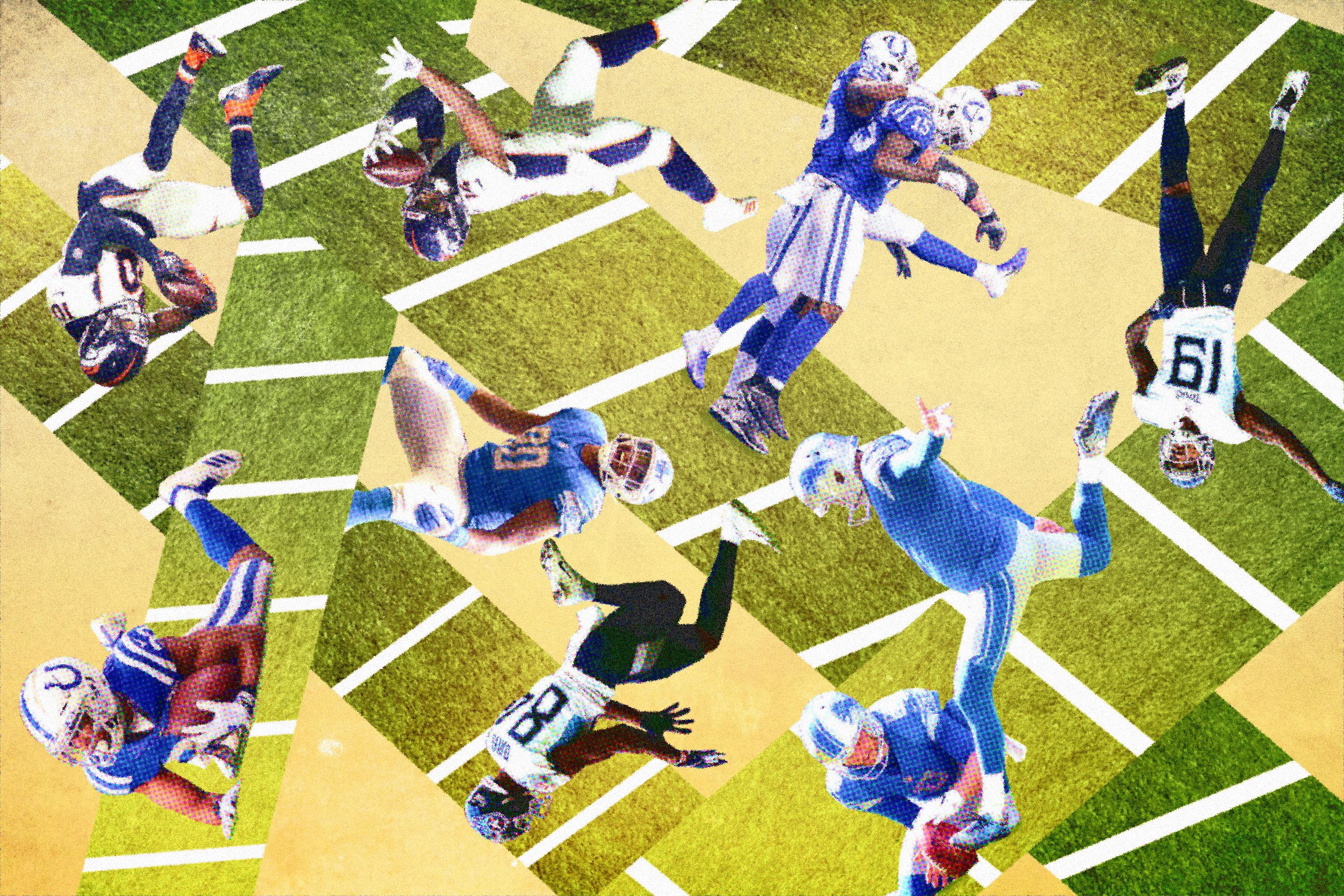
We’ve reached the point in the season when it’s beginning to become pretty clear what most teams are. The Rams and Chiefs are both unstoppable offensive juggernauts and Super Bowl favorites. The Patriots are still, well, the Patriots; the Packers are only as good as Aaron Rodgers can carry them; and the Chargers are both as talented and untrustworthy as ever. The Giants and Raiders are tanking; the Bills offense is so bad it doesn’t matter that their defense is solid; and the Browns and Jets are still a year or two away from contending.
But there are still a few teams that I can’t quite figure out. Whether it’s due to wild inconsistencies week to week or their amorphous, indiscernible identities, it’s hard to fit these squads into any particular category—making it just as tough to cross them off the postseason list as it is to count them in. As we head into Week 8, the Broncos, Colts, Lions, and Titans are the most NFL’s perplexing teams.
Denver Broncos (3-4)
There’s a truism in football that good teams dominate bad teams. That sounds totally obvious, but it’s not insignificant: With so many variables in play in any given game, a close loss doesn’t necessarily tell us more about the overall quality of a particular squad than a narrow victory. Sometimes you just get a few bad bounces or a crucial drop, or your kicker clanks one off the upright. But a blowout? That can reveal a team’s true character.
It looked an awful lot like the Broncos were really, really bad when they got shellacked by a rookie-quarterback-led New York offense in the team’s 34-16 loss in Week 5. Denver gave up more than 500 yards of offense in that one, including 323 yards on the ground — it was ugly enough that I all but wrote it off. That stance softened in Week 6, though, as I watched Denver play the Rams tough, eventually losing a hard-fought 23-20 grudge match in subfreezing weather. Then last week, as the Broncos completely annihilated the Cardinals on Thursday Night Football, a thought creeped into my mind: Maybe Denver is actually … good … ? We know the Cardinals are awful, and don’t good teams dominate bad teams?
The Broncos sit in the no. 5 spot of Football Outsiders’ DVOA rankings this week. FO editor-in-chief Aaron Schatz went into detail about that supposed anomaly, noting that Denver’s ranking wasn’t just a function of the team’s 45-10 blowout over the Cardinals, but was also due to the team’s sixth-ranked strength of schedule through the first six weeks. With a Week 1 win over the Seahawks (10th in DVOA), a Week 3 loss to the Ravens (fourth), and losses to the Chiefs (first) and Rams (second) by a combined seven points, perhaps the narrative around the Broncos is being driven a little too much by the wins column.
Denver is in the black in point differential (plus-1), is relatively balanced on both sides of the ball (seventh in offensive DVOA, eighth on defense) and comes replete with star players at a few of the sport’s most crucial spots in pass rusher Von Miller, cornerback Chris Harris, and receiver Emmanuel Sanders. Past that, the team’s two rookie backs—Phillip Lindsay and Royce Freeman—have been outstanding this year, leading the charge for one of the league’s top rushing attacks, and rookie outside linebacker Bradley Chubb is starting to hit his groove, with five sacks in the last two games. Of course, the counterbalance to all of that has been Case Keenum, who hasn’t been able to rein in his penchant for back-breaking turnovers. Signed over the offseason to a two-year, $36 million deal, the former Viking was supposed to bring stability to the position. He’s done the opposite, tossing nine picks in seven games.
So are the Broncos the team that got blown out by the Jets, or the one that destroyed the Cardinals and narrowly lost to the league’s best two teams? I still lean toward the former, but much depends on what Denver gets out of Keenum down the stretch. If the 30-year-old passer can start to play at a level anywhere close to what we saw last year—he threw just seven picks on 481 attempts—imagine the difference it’d make for the team as a whole.
Indianapolis Colts (2-5)
The Colts were supposed to be bad. They’re transitioning to a new head coach and play-caller, and a new defensive coordinator; their roster is thin; the defense is a bunch of no-namers; the offensive line needs work; they’ve got only one reliable receiver; the running backs suck; their tight end is Eric Ebron; Andrew Luck’s arm might fall off.
And through seven weeks, the Colts’ record has been bad. They’re 2-5, 25th in points allowed, in last place in the AFC South, 1-4 in the conference. So why does it feel like the Colts are actually kind of good?
For starters, Luck’s arm is still, in fact, attached, and the veteran passer is beginning to look like his old, playmaking self, elevating the players around him. He’s attacking downfield with growing confidence. The line has been solid. Ebron has caught six touchdowns (!). T.Y. Hilton, finally healthy, is back to being the team’s legit go-to guy, and even the run game is starting to click, with Marlon Mack and Nyheim Hines coming on strong over the past few weeks. Defensively, rookie linebacker Darius Leonard has been a revelation. Second-year safety Malik Hooker is back off his torn ACL and MCL, and is playing at a high level. Veteran Mike Mitchell is Pro Football Focus’s top-rated safety. Pass rusher Margus Hunt, at age 31, is having a breakout year.
I’d guess that plenty of people have already written the Colts off, but this surprisingly plucky squad is not only starting to coalesce into what looks like a real team, but has one of the easiest second-half schedules in the league. In the wide-open AFC South, Indy could still be a playoff team.
Detroit Lions (3-3)
When you picture the Lions, what comes to mind? The team that looked completely inept in a Week 1 blowout loss to the Jets, or the one that dominated the Patriots two weeks later? You might say that Detroit lies somewhere in between, but this team has mostly lived on the two extremes. To wit: No team has had higher week-to-week variance in DVOA this year.
With a new, first-time head coach, a bevy of new players, and a new defensive playbook, it’s clear that this Lions team is still trying to figure out who they are. Offensively, they’re attempting to transform from one of the most pass-heavy teams in the league to one with a real run game. That process was pretty clunky at first, no doubt slowed Matt Patricia’s seeming reluctance to give too many carries to the team’s electric playmaking rookie back, Kerryon Johnson. And defensively, the lack of a consistent pass rush and a nonexistent run defense has hindered the transition to Patricia’s scheme under new defensive coordinator Paul Pasqualoni. Through seven weeks, Detroit ranks 28th in overall DVOA, and Football Outsiders pegs their playoff probability at just 15.7 percent.
Yet I find myself strangely believing in this Lions squad. The trade for Giants defensive tackle Damon Harrison should help shore up the team’s porous run defense, and when Ezekiel Ansah gets back onto the field (he’s missed the last five games with a shoulder injury), he could provide a spark for the struggling edge rush. And with Matthew Stafford throwing to the league’s top receiver trio in Golden Tate, Kenny Golladay, and Marvin Jones Jr., and now handing off to one of the most exciting young running backs in Johnson, Detroit is just scratching the surface of its offensive potential. The Lions don’t look like the finesse teams we saw over the past few years, and if they can hold onto and embrace their new identity, it could be enough for a run at the playoffs in a season when no one can apparently play defense.
Tennessee Titans (3-4)
Coming into the season, I expected quarterback Marcus Mariota to take a huge step forward under new offensive coordinator Matt LaFleur, who came from the Rams. Through seven weeks, we’ve seen a few glimpses of that upside, but thanks in part to an injury to his throwing elbow suffered in Week 1, Mariota has been wildly inconsistent, vacillating between the dynamic, dual-threat weapon we thought he’d be and something resembling Nathan Peterman.
The Titans offense has followed suit. Without any semblance of a run game to fall back on, Tennessee’s success rests on what the team gets from its unpredictable signal-caller. In Week 4, the Titans beat the defending champion Eagles, 26-23, on the back of Mariota’s steely game-winning overtime drive. Then, the next week, they turned around and lost to the Bills, no thanks to a 129-yard, one-interception day from the fourth-year pro. Against the Ravens in Week 6, Mariota looked lost, taking 11 sacks on just 26 dropbacks, and then last week against a balanced Chargers defense, he bounced back, throwing for 237 yards and a score while adding 38 yards with his feet. The end of that game served as a microcosm for the whole season: Mariota cooly led the Titans downfield, tossing a touchdown to tight end Luke Stocker that pulled the team to within one point with 35 seconds to go—then things promptly went haywire. Instead of kicking the extra point to send it into overtime, head coach Mike Vrabel went for two and the win. After getting bailed out by a defensive holding call on the unsuccessful first try, Mariota forced an off-target, no-chance desperation throw over the middle on the second. It fell incomplete.
Somehow, Tennessee is still in second place in the division and firmly in the playoff hunt. But its postseason hopes are pinned to the play of its inconsistent, possibly injured quarterback. At times, it looks like Mariota has turned the corner to help transform a boring offense into a high-flying, well-oiled machine. And at others, he falters, and it all grinds quickly to a halt. It’s anybody’s guess what we’ll see this week.

